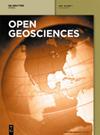Structural features and tectonic activity of the Weihe Fault, central China
IF 1.3
4区 地球科学
Q3 GEOSCIENCES, MULTIDISCIPLINARY
引用次数: 0
Abstract
The study of tectonic activity holds great significance in assessing historical and modern seismic risks. The Weihe Graben is a significant intracontinental graben system in China, with numerous active faults that have caused a series of earthquakes, including the Huaxian great earthquake (中国中部渭河断层的构造特征和构造活动
构造活动研究对于评估历史和现代地震风险具有重要意义。渭河地堑是中国一个重要的大陆内地堑系统,有许多活动断层,曾引发一系列地震,包括 1556 年的华县大地震(M ∼ 8.5),造成约 83 万人死亡。尽管渭河断层与这些地震之间存在明显的空间关系,但对该断层的详细研究仍然缺乏。我们利用遥感图像、数字高程模型、浅层地震测线、沟槽挖掘、钻探剖面和光激发发光测年等多种技术,得出了以下结果:(1)渭河断层穿过咸阳北部渭河阶地的陡崖,在金家村可分为东西两段;(2)渭河断层为正断层,走向东北,倾角65°-75°,倾角南倾;(3)该断层在全新世期间一直处于活动状态;(4)垂直偏移和测年结果表明,自更新世晚期以来,断层活动逐渐减弱,全新世期间的垂直滑动速率仅为0.04-0.13毫米/年。04-0.13 毫米/年。
本文章由计算机程序翻译,如有差异,请以英文原文为准。
求助全文
约1分钟内获得全文
求助全文
来源期刊

Open Geosciences
GEOSCIENCES, MULTIDISCIPLINARY-
CiteScore
3.10
自引率
10.00%
发文量
63
审稿时长
15 weeks
期刊介绍:
Open Geosciences (formerly Central European Journal of Geosciences - CEJG) is an open access, peer-reviewed journal publishing original research results from all fields of Earth Sciences such as: Atmospheric Sciences, Geology, Geophysics, Geography, Oceanography and Hydrology, Glaciology, Speleology, Volcanology, Soil Science, Palaeoecology, Geotourism, Geoinformatics, Geostatistics.
 求助内容:
求助内容: 应助结果提醒方式:
应助结果提醒方式:


